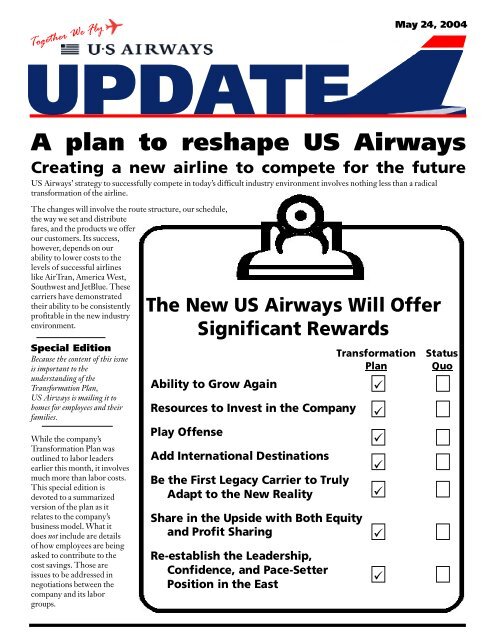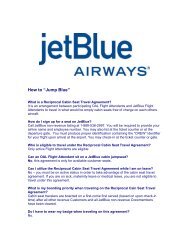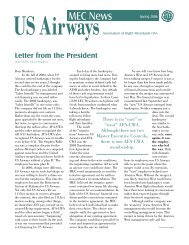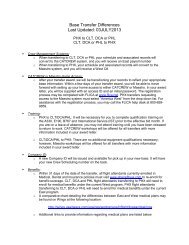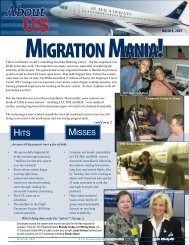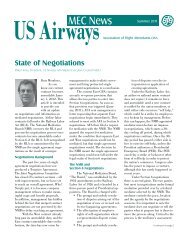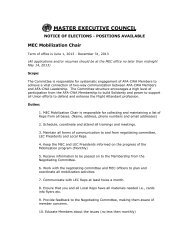update - AFA USAirways
update - AFA USAirways
update - AFA USAirways
You also want an ePaper? Increase the reach of your titles
YUMPU automatically turns print PDFs into web optimized ePapers that Google loves.
Together We Fly<br />
May 24, 2004<br />
UPDATE<br />
A plan to reshape US Airways<br />
Creating a new airline to compete for the future<br />
US Airways’ strategy to successfully compete in today’s difficult industry environment involves nothing less than a radical<br />
transformation of the airline.<br />
The changes will involve the route structure, our schedule,<br />
the way we set and distribute<br />
fares, and the products we offer<br />
our customers. Its success,<br />
however, depends on our<br />
ability to lower costs to the<br />
levels of successful airlines<br />
like AirTran, America West,<br />
Southwest and JetBlue. These<br />
carriers have demonstrated<br />
their ability to be consistently<br />
profitable in the new industry<br />
environment.<br />
Special Edition<br />
Because the content of this issue<br />
is important to the<br />
understanding of the<br />
Transformation Plan,<br />
US Airways is mailing it to<br />
homes for employees and their<br />
families.<br />
While the company’s<br />
Transformation Plan was<br />
outlined to labor leaders<br />
earlier this month, it involves<br />
much more than labor costs.<br />
This special edition is<br />
devoted to a summarized<br />
version of the plan as it<br />
relates to the company’s<br />
business model. What it<br />
does not include are details<br />
of how employees are being<br />
asked to contribute to the<br />
cost savings. Those are<br />
issues to be addressed in<br />
negotiations between the<br />
company and its labor<br />
groups.<br />
The New US Airways Will Offer<br />
Significant Rewards<br />
Ability to Grow Again<br />
Resources to Invest in the Company<br />
Play Offense<br />
Add International Destinations<br />
Be the First Legacy Carrier to Truly<br />
Adapt to the New Reality<br />
Share in the Upside with Both Equity<br />
and Profit Sharing<br />
Re-establish the Leadership,<br />
Confidence, and Pace-Setter<br />
Position in the East<br />
Transformation<br />
Plan<br />
<br />
<br />
<br />
<br />
<br />
<br />
<br />
Status<br />
Quo
2<br />
UPDATE<br />
Transforming … where we fly<br />
Focus to shift to larger local markets<br />
Local Markets’ Revenue<br />
<br />
<br />
New York<br />
Local Market Yields Are Higher Than Connect<br />
With Small Local Markets, CLT & PIT Rely More on Connecting Traffic<br />
3,788<br />
Wash, DC<br />
* *<br />
Chicago<br />
LAX<br />
1,683<br />
Dallas<br />
ATL<br />
Domestic Annual O&D Revenue ($mil)<br />
SFO<br />
BOS<br />
*<br />
DEN<br />
Houston<br />
MSP<br />
1,019<br />
PHL<br />
DTW<br />
MIA<br />
SLC<br />
478 473<br />
Like the rest of the so-called legacy carriers, US Airways<br />
primarily operates a hub-and-spoke network. Hundreds of<br />
flights from spoke cities converge in waves many times a day on<br />
our three hubs at Charlotte, Philadelphia and Pittsburgh, where<br />
passengers connect and fly out to their final destination.<br />
While the hub system is a marvelous collector of revenue, it is<br />
also more expensive to operate than point-to-point flights.<br />
Large numbers of gates, equipment and employees are needed<br />
to handle the peaks when aircraft are in the hubs. But during the<br />
down times, these resources sit idle. The hub system also limits<br />
the number of hours per day each aircraft can fly.<br />
Legacy carrier hubs also used to be a “safe haven” to hide in as<br />
the low-cost carriers (LCCs) expanded elsewhere, said Andrew<br />
Nocella, vice president of network and revenue management.<br />
Over the years, US Airways retreated from or downgraded most<br />
of its point-to-point routes to its hubs as low-cost carriers<br />
expanded. “With our hubs now under direct attack from the<br />
LCCs, we no longer have any place to retreat to,” he said.<br />
In the past, the revenue premiums generated by the hub system<br />
more than offset its incremental costs versus a point-to-point<br />
network. This was possible with higher fare levels offered in the<br />
hub local markets in exchange for nonstop service. Further, the<br />
LCCs had not tapped into the revenue stream in many smaller<br />
regional markets in the Northeast. However, this equation has<br />
changed, which requires a transformation of the way we do<br />
business and how we schedule the airline, Nocella explained.<br />
Local market yields (calculated by dividing passenger revenue<br />
by passenger miles and expressed in cents) are higher than in<br />
CLT<br />
PIT<br />
CLE<br />
IND<br />
385<br />
CVG<br />
MEM<br />
* US Airways’ asset strengths<br />
connecting markets. In a hub, the major<br />
carrier can command a premium for<br />
frequent non-stop flights. However,<br />
passengers in spoke cities, who will<br />
likely have to connect at some airline’s<br />
hub to get to their destination, have an<br />
array of choices. Their fares — and the<br />
yield to an airline – are lower, reflecting<br />
this competition.<br />
With their relatively small local market<br />
size, Pittsburgh and Charlotte rely far<br />
more on connecting traffic than<br />
originating passengers. Philadelphia,<br />
meanwhile, is the fifth largest<br />
metropolitan area in the U.S., and<br />
US Airways currently captures 48<br />
percent of the local traffic there.<br />
Under the Transformation Plan,<br />
US Airways’ schedule will be more<br />
focused on larger local markets because<br />
that’s where yields are highest - - and<br />
that is where people want to go. Our<br />
goal is to recapture the number one market share position in<br />
the East through more point-to-point flying and a stronger<br />
focus on LaGuardia, Boston and Washington National with the<br />
US Airways Shuttle as the centerpiece of the operation.<br />
Because of its large population size, Philadelphia will remain at<br />
the core of our network. US Airways has the single largest<br />
number of gates there, including new international and<br />
US Airways Express facilities, and Philadelphia’s geography<br />
also makes it a good gateway city to Europe and the Caribbean.<br />
New York and Washington, D.C., are the nation’s two largest<br />
O&D (origination and destination) markets and Boston is<br />
eighth. US Airways already has a large presence and superb<br />
facilities in all three locations, and these will be leveraged by<br />
providing more point-to-point service. Connecting traffic is<br />
important even in these markets but less so than local<br />
passengers.<br />
Non-stop service will be scheduled to key business and leisure<br />
markets from these three cities. Aircraft utilization will be high<br />
and turn times will be speedy — much like the operations of the<br />
low-cost carriers. The plan includes US Airways returning to<br />
many markets that were abandoned when our costs were higher<br />
than the competition, including New York La Guardia to<br />
Florida, Nocella said.<br />
Under the plan, Charlotte’s strategic position as an effective<br />
hub will permit more Caribbean service and will allow for<br />
more growth of both domestic and international service. It will<br />
operate closer to a traditional hub with more banks, but with<br />
some flattening, or de-peaking of flights, to add efficiency.<br />
Continued on page 3
UPDATE<br />
Transforming . . . where we fly (continued)<br />
Conversion to a point-to-point operation in Charlotte would<br />
have required a significant reduction in the number of flights<br />
and destinations as the local market is not large enough.<br />
Instead, US Airways will grow Charlotte and make it our<br />
primary connecting operation.<br />
The strategy also envisions that Pittsburgh will not operate as a<br />
traditional hub, but instead become a focus city, with<br />
US Airways remaining the leading carrier there, but with fewer<br />
flights and nonstop destinations. As the leading airline in<br />
Pittsburgh US Airways will continue to serve cities where<br />
people in Pittsburgh travel frequently and offer them lower<br />
fares in the process. Smaller markets that have little demand to<br />
and from Pittsburgh likely will lose service. In some situations,<br />
service to these smaller cities will be maintained to<br />
Philadelphia or Charlotte. The final mix of regional jet<br />
departures versus mainline jets will be determined upon how<br />
much local demand there is to and from Pittsburgh.<br />
Transforming … how we sell<br />
Reducing distribution costs will be key<br />
Simplifying our pricing structure will be another vital piece of<br />
US Airways’ successful transformation. Since pricing and<br />
distribution go hand in hand, the effort to simplify pricing and<br />
lower our distribution costs is paramount. These efforts are<br />
already under way and continue to be refined.<br />
The first example of US Airways’ simplified pricing structure is<br />
GoFares, which were introduced in the Philadelphia market on<br />
April 29 as a response to the competitive challenge there.<br />
GoFares is a new, permanent and simplified program of low<br />
prices featuring one-way fares starting as low as $29 and a cap<br />
of no more than $499.<br />
“We have heard our customers loudly and clearly,” said Senior<br />
Vice President of Marketing and Planning Ben Baldanza. “Low<br />
fares are a reality of the marketplace and US Airways is<br />
adapting to these changing realities.”<br />
As we continue to simplify our complex fare system, we will<br />
further reduce our distribution costs. Reductions in<br />
Reservations call times and in customer hold times will<br />
naturally result as change fees and other rules are eliminated.<br />
Airport processing delays also will diminish, along with<br />
customer wait times and complaints.<br />
Ongoing enhancements to usairways.com are helping to simplify<br />
how tickets are sold and distributed. US Airways’ Web site is<br />
the most efficient, low-cost distribution channel to maintain,<br />
and the goal is to double the percentage of online sales we<br />
receive at our Web site – from 10 percent to 20 percent – by<br />
year-end.<br />
To boost use of usairways.com and avoid expensive global<br />
distribution system charges, we are investing to make the site<br />
Operations at Philadelphia under the new plan will be “depeaked,”<br />
meaning domestic flights will not be bunched up in<br />
waves to accommodate connections, but scheduled more on a<br />
“rolling” basis targeted at local customers. Feed for<br />
transatlantic and Caribbean flights, however, will continue. Depeaking<br />
the schedule will allow US Airway to expand the<br />
number of flights it offers in Philadelphia while maintaining or<br />
improving reliability.<br />
As the schedule is de-peaked in various locations, operational<br />
cost reductions result. For instance, fewer gates and less ground<br />
equipment are required. With less congestion, there are<br />
reduced taxi-out and enroute delays. In this scenario fewer<br />
passengers and bags misconnect and there are more efficient<br />
crew pairings. Also, there are more and better maintenance<br />
opportunities to enhance schedule integrity.<br />
However, simply de-peaking the schedule without simplifying<br />
and lowering fares and other operating costs would put the<br />
company further in the red.<br />
more reliable and simpler to use, and will continue to promote<br />
usairways.com with special marketing campaigns to entice<br />
customers to use the Web site.<br />
Another key goal for usairways.com is to migrate a significant<br />
amount of service transactions to the Web site by adding new<br />
self-service features and making the site more intuitive and<br />
reliable for customers to use. This will enable customers to<br />
complete more of their travel transactions online.<br />
“Customers’ willingness to manage their travel experience online,<br />
coupled with the changes we are making to usairways.com,<br />
is fueling a lot of growth for our Web channel,” said Managing<br />
Director E-Commerce Mark Kuhns. “Customers are turning<br />
to the Web site to complete a number of transactions, from<br />
shopping and booking tickets, to printing boarding passes,<br />
applying upgrades and selecting seat assignments, to managing<br />
their Dividend Miles accounts on-line.”<br />
In addition, E-Commerce has been working to integrate<br />
functionality with airport kiosks to further enhance customer<br />
convenience. For example, if customers print their boarding<br />
pass at usairways.com and arrive at the airport without it, they<br />
can now proceed directly to the kiosk and re-print their<br />
boarding pass.<br />
“All of these changes are moving us toward our common goal,<br />
which is to provide our customers with a highly reliable, cost<br />
effective, preferred channel to manage their US Airways travel.<br />
When customers choose this channel, they will be rewarded<br />
with benefits, such as lower fares, or Dividend Miles, which<br />
may not be available through other more costly distribution<br />
channels.” said Kuhns.<br />
3
UPDATE<br />
Transforming … our cost structure<br />
Entire business plan hinges on lower expenses<br />
US Airways’ Transformation Plan hinges on successfully<br />
lowering our cost structure.<br />
Consumers are demanding lower, simpler fares and carriers<br />
like Southwest, America West, AirTran and JetBlue have been<br />
successful because they are able to provide what customers<br />
want. Budget airlines now account for nearly a third of<br />
domestic capacity, up nine percentage points just since 2000<br />
and are expected to top 40 percent by the end of the decade.<br />
To maintain current market share and to even entertain notions of<br />
growth will require US Airways to be competitive in this low-fare<br />
environment. But without lower costs, the initiative to provide<br />
10.02<br />
CASM excluding fuel, Q1 2004<br />
9.04 8.61 8.46 8.39 7.85 7.73<br />
6.57 6.42 6.08 5.86<br />
4.88<br />
US DL AS UA NW CO AA WN FL HP TZ B6<br />
simpler, lower fares cannot be sustained. And without changing the<br />
fare structure, de-peaking our schedule and remaking the network<br />
would only result in larger financial losses.<br />
Cost savings will come primarily from two important sources<br />
— more efficient operations and labor savings.<br />
US Airways Web site are designed to attract more online<br />
bookings and use of e-tickets, thereby lowering distribution<br />
costs.<br />
· Advertising low fares. With advertising driving more<br />
consumers to usairways.com, the amount of fees the company<br />
pays to CRS systems will drop.<br />
These are radical changes to the US Airways business model,<br />
but without them, the company will not be able to compete on<br />
price. Regrettably, as productivity increases are realized, some<br />
of these changes will result in furloughs. But once US Airways is<br />
cost-competitive, growth and recalls can become a reality — a<br />
situation that simply cannot occur<br />
under the status quo.<br />
Employee costs will need to be<br />
compared along five dimensions: rates<br />
of pay; seniority; benefits; productivity<br />
and scope. President and CEO Bruce<br />
Lakefield said the approach to lower<br />
labor costs must be fair. No single work<br />
group will subsidize another’s lack of<br />
marketplace competitiveness, nor can<br />
employees subsidize waste or mistakes<br />
made by management, he said.<br />
The new US Airways labor cost<br />
structure must be based on that of our<br />
profitable competitors, such as<br />
America West, which operates a<br />
network system, and JetBlue, which<br />
operates point-to-point.<br />
Every employee group will need to compare itself to the<br />
industry’s “best practices” for their respective group.<br />
Management has acknowledged that profit sharing with all<br />
employees must be a part of the plan so that employees can<br />
share in the upside of success.<br />
Management actions will provide the structure required to<br />
compete. These include:<br />
· Increased aircraft utilization. This will improve productivity<br />
of employees both in the air and on the ground.<br />
· De-peaking hub schedules. This also will improve<br />
employee productivity and lead to fewer misconnected<br />
passengers, lost bags and flight delays.<br />
· Lower, simpler fares. With a less complex fare structure,<br />
Reservations talk time goes down and productivity rises. The<br />
sales department will have fewer complex contracts to<br />
manage, resulting in lower selling costs. And customers will<br />
have fewer complaints.<br />
· Automation. In airports, increasing use of kiosks results in<br />
lower costs and higher productivity, as will gate readers when<br />
they begin to be installed this year. Improvements to the<br />
4<br />
UPDATE<br />
US Airways Corporate Communications<br />
2345 Crystal Dr. Arlington, VA 22227<br />
Tel: 703-872-5100 Fax: 703-872-5104<br />
Comat code: DCA H/850<br />
Lotus Notes/PROFS: usnews<br />
Email: usnews@usairways.com<br />
Editor: John Bronson, director of Corporate<br />
Communications<br />
Publisher: Office Services - Pittsburgh<br />
Contributors: Amy Phoenik, manager of Employee<br />
Communications


